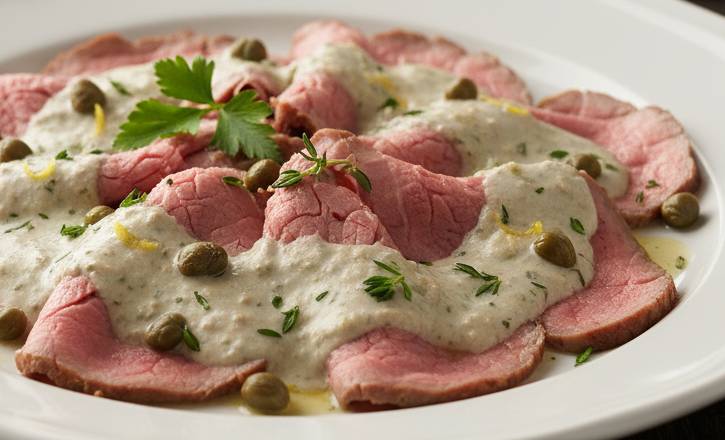
Vitello Tonnato is a classic Italian dish that features thinly sliced, cold veal topped with a creamy tuna sauce. While the dish is served cold, the key to its success lies in cooking the veal to a perfect medium-rare doneness. This ensures the meat is tender, moist, and flavorful, providing an ideal contrast to the rich, savory sauce. So, what temperature do you cook vitello tonnato to? The answer is a precise internal temperature that guarantees a “perfectly ripe” veal loin.
The Ideal Temperature: Medium-Rare
For Vitello Tonnato, the veal loin should be cooked to an internal temperature of 130-135°F (54-57°C). This range achieves a perfect medium-rare doneness, where the center of the meat is still a light pink and incredibly juicy. Cooking it any more will make the veal tough and dry, which is the opposite of what you want for this elegant dish.
Cooking the Veal: A Simple Guide
Ingredients:
- 1 veal loin roast (around 2-3 lbs)
- 2 tbsp olive oil
- Salt and black pepper
Step by step:
Step 1: Prep the Veal
Pat the veal roast completely dry with paper towels. This is crucial for a good sear. Season it generously on all sides with salt and black pepper.
Step 2: Sear for Flavor
Heat the olive oil in a heavy-bottomed skillet or Dutch oven over medium-high heat. Once the oil shimmers, carefully place the veal in the pan. Sear on all sides until a beautiful golden-brown crust forms. This should take about 2-3 minutes per side. The goal here is to build flavor, not to cook the meat through.
Step 3: Roast to Perfection
Transfer the seared veal roast to a preheated oven at 375°F (190°C). Roast for about 25-35 minutes. This is where a meat thermometer is essential. Insert the thermometer into the thickest part of the roast, avoiding the bone if there is one.
Step 4: Check the Temperature
Begin checking the temperature after about 25 minutes. When the thermometer reads 130-135°F (54-57°C), remove the veal from the oven.
Step 5: Rest the Meat
This is the most critical step. Loosely tent the veal with foil and let it rest for at least 15-20 minutes. During this time, the internal temperature will continue to rise slightly, and the juices will redistribute throughout the meat, ensuring a tender and juicy final product.
Conclusion
The secret to perfect Vitello Tonnato isn’t a complex cooking method, but rather a precise focus on temperature. By searing the veal for a deep, rich flavor and then roasting it to a medium-rare 130-135°F (54-57°C), you ensure a tender, moist, and flavorful base for your dish. Once the veal has rested, it can be chilled, thinly sliced, and topped with the classic tuna sauce, creating a light, yet rich, appetizer or main course.
FAQ
Q: Can I use a different cut of veal?
A: Veal loin is the traditional cut for Vitello Tonnato because it’s tender and lean. You can also use a veal round roast or top sirloin, but be aware that the texture may vary slightly. Avoid using veal shank or shoulder, as these cuts are best for slow braising.
Q: Why is resting the meat so important?
A: Resting allows the juices to redistribute throughout the meat. If you slice the veal immediately after cooking, all the juices will run out, leaving you with a dry piece of meat. The resting period locks in moisture, resulting in a much more tender and juicy slice.
Q: Can I prepare the veal ahead of time?
A: Yes, you can. After cooking and resting the veal, you can chill it in the refrigerator. In fact, Vitello Tonnato is meant to be served cold, so this is a required step. You can prepare the veal up to two days in advance.
Q: What if I don’t have a meat thermometer?
A: While a meat thermometer is the most reliable way to check for doneness, you can use the touch test as an alternative. A medium-rare piece of meat will feel soft and springy to the touch. It will have a slight give, similar to the fleshy part of your palm when you touch your thumb to your pinky finger.
Q: Why does the recipe call for a high-temperature roast?
A: Roasting at a higher temperature, such as 375°F (190°C), creates a beautiful crust on the outside of the veal while the inside remains moist and perfectly pink. A lower temperature would result in a less appealing gray color on the outside.